#i keep trying not to brainrot about trolls on main
Explore tagged Tumblr posts
Text
in case you don't live forever by ben platt is so branch coded the urge to write fanfic is killing me rn
like he knows poppy wont live forever and he's not gonna lie to himself that she might get hurt or die, and his arc is literally just him saying 'screw it, living well is better than living safe' and choosing to love her anyway and aghhhhhhhh
#branch#trolls branch#music#ben platt#i keep trying not to brainrot about trolls on main#idk if i just know i don't have time for another muse#or if it's just me being afraid of being cringe#on the literal cringe website#but screw it#branch taught me some stuff about myself#and i love the trops#and music#and everything that speaks to you deserves to be explored#so cringecore is back baby
2 notes
·
View notes
Text
Random WHB tier lists based on games/franchises I've recently had brainrot of
I may not play WHB regularly now (no, seriously, last time I played was during the Tortured Leviathan Nightmare Pass, then Girls Frontline 2: Exilium and especially my Puyo Puyo + Trauma Center obsessions resurfacing from high school happened) but I still love some characters a bit too much to truly let go of them aha...Marbas, Lucifer, Minhyeok, Belial, Gusion, and Naberius, my beloveds-
But more than that I guess it's more of like...my old obsessions being annoying brainworms again, which leads to brainrot, essentially. That, and watching an unhealthy amount of League of Legends esports content.
Fair warning that most of these are purely based off vibes!
So, without further ado...
1.WHB as MOBA players when facing an OP character
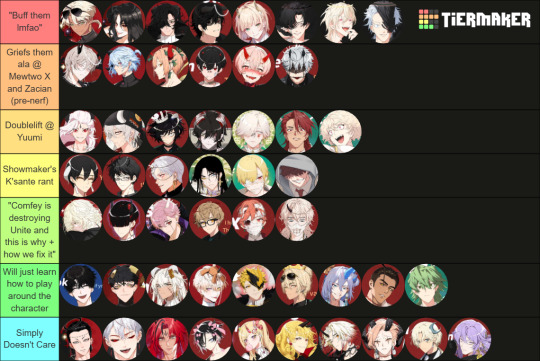
Yes, this is the MOBA brainrot speaking.
As for tier explanations:
Tier 1: Some people just want to watch the world burn.
Tier 2: When Mewtwo X and Zacian were first released in Pokemon Unite, many players were so disgusted by how utterly overpowered they were (these two Mons can easily 1v5 coordinated efforts to kill them, even in the hands of not-so-skilled players). It got to a point a subset of these disgusted players actively griefed and trolled those who played them.
Tier 3: Doublelift had this to say about Yuumi, who was a notoriously overpowered Support in League of Legends:
"I am not kidding when I say that if they removed Yuumi from [League of Legends], it would be a better game."
Tier 4: Heo "ShowMaker" Su, professional League of Legends player, had this to say about the then-OP Champion known as K'Sante...keep in mind this is just the K'sante rant, which has become a meme, and the original stream highlight as uploaded by his esports team (Dplus KIA) was simply titled "NERF THIS".
youtube
Tier 5: Comfey is essentially Yuumi in Pokemon Unite, which is why people said it's overpowered in coordinated play. Notably, spragels has an entire video going in-depth about how Comfey breaks the game and how to, essentially, mitigate the sheer brokenness of the Mon.
Tiers 6 and 7: self-explanatory
2. WHB as Arknights Icebreaker Games players
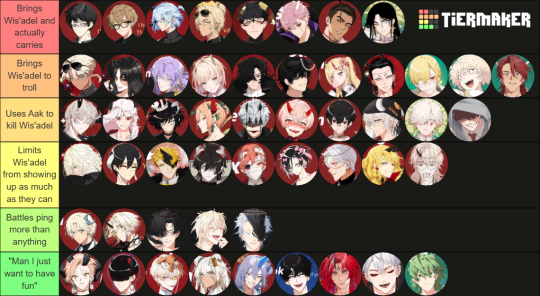
A bit of context - Icebreaker Games was a multiplayer co-op game mode where players deploy their own squad of units on the same map (this was different from the R6S collaboration event's co-op game mode, where both players are on different but connected maps).
Wis'adel is an absolutely BROKEN Operator whose usage was criticized in Icebreaker Games for being such an insane DPS she essentially ignores stage mechanics and having her Revenants taking up three extra deployment tiles that your teammate might want to use. She absolutely can easily win stages (tier 1) but her Revenants is how most people who want to troll use her (tier 2).
Seeing this, many players attempt to try and limit Wis'adel from ever being used. Some do it in a more violent way using Aak (tier 3) - who inflicts damage on an Operator in his range before buffing them. He's most commonly to buff Operators with high Defense...a stat Wis'adel lacks, so she just Dies.
More peaceful players would put Wis'adel in their subs and simply Not Pick Her whenever she shows up in their randomly-generated picks (tier 4). Not the most foolproof strategy, but it helps.
Last two tiers are, again, self-explanatory.
3. WHB as Puyo-Puyo AI levels
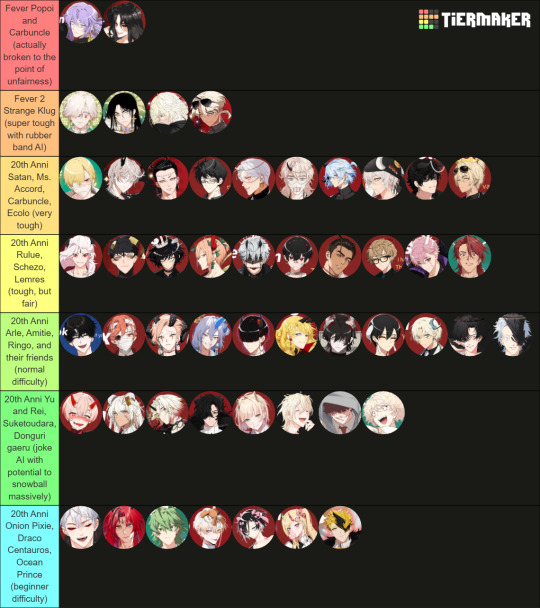
Puyo Puyo is a competitive puzzle game where your main goal is to make your opponent's board fill up to the 'X' of their field. You do this by sending what is known as Nuisance Puyo to your opponents, generated by popping the regular Puyo you drop into your field.
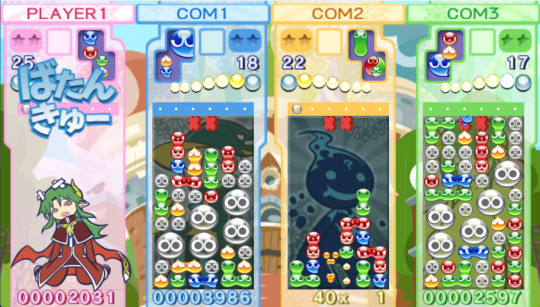
Regular Puyo, which are the colored blobs, are cleared by matching four of the same color together. Nuisance Puyo, the grey blobs seen in Lemres (COM1) and Yellow Satan's (COM3) fields, can only be cleared by clearing regular Puyo touching them. You are expected to create chains in order to generate more Nuisance Puyo by arranging your regular Puyos in a way that when one regular Puyo set is cleared, it'll cause another regular Puyo set to be cleared - like what Ecolo (COM2) is doing to the red Puyo set by clearing the yellow Puyos below it. The row on top of your board gives a visual indicator of how many Nuisance Puyo are about to be dropped onto your field (the limit is six rows at once), and you can chip away at it by clearing Puyo chains of your own (otherwise known as offsetting).
The general difficulties are as follows, starting from the ones at the bottom (i.e. easiest difficulty):
Beginner difficulty: allows gravity to drop the Puyo, doesn't really try to form a chain higher than 2. Rotates their Puyo minimally.
Joke AI: uses fast drop to build their joke build before actually playing, prioritizing clearing Puyos in their joke build. Their joke builds may include stacking all Puyos to the sides (Yu and Rei, Dongurigaeru), or stacking Puyo evenly up to a certain height (Suketoudara).
Normal difficulty: will actively attempt to make chains (a 3-chain is the average), but will still let gravity drop their Puyo - until around halfway down the field, where they will then fast drop the Puyo.
Tough, but fair: will bunch Puyos up in threes for ease in chaining, it's not uncommon for them to suddenly pull out 3+ chains. Will fast-drop their Puyo. Starting here, the AI will rush to start a chain to offset any incoming attacks. In 20th Anniversary, in game modes where rotate-stalling is a legitimate strategy to win, they'll do it.
Very tough: the previous tier, cranked up to 11.
Rubber band AI: the AI plays better when you play better...but the issue is that Strange Klug is essentially the final boss of Fever 2, so his base difficulty is already hard.
Unfair: can and will counter your measly 3-chain with a 7-chain, essentially generating enough Nuisance Puyo to fill your board completely unless you offset it. Plays optimally and shows no mercy, including stalling and fast/hard-dropping Puyo in modes that allow them (instantly teleports Puyo to the bottom of the field).
4. WHB in Trauma Team game modes
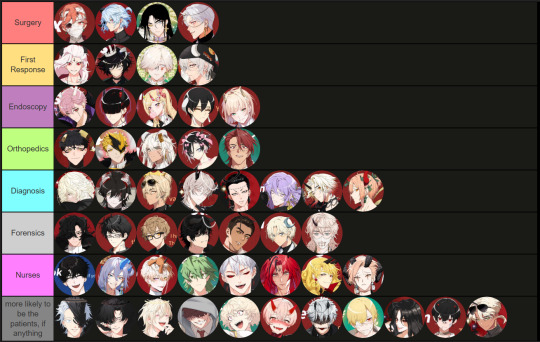
Disclaimer: This tier list is made while ignoring the fact that all of them, save for the Paradise Lost demons, absolutely cannot function in an actual hospital scenario.
Trauma Team, released in 2010, is the final instalment in the Trauma Center franchise, a series of medical malpractice- I mean anime surgery simulator games by Atlus (famously known for the Shin Megami Tensei games). We use the term 'surgery simulator' very lightly because, well, it's very anime at times (you fight bioweapons in all previous instalments) and there are still some medical inaccuracies (like operating on a still-beating heart).
Trauma Team, for the most part, is tamer compared to all of its previous instalments. Very standard hospital procedures - until the Rosalia chapter, where you deal with the Rosalia Virus epidemic (which becomes harsher in hindsight when you realize Trauma Team's events happened in 2020 of their canon and the Rosalia Virus is an Ebola-type virus). It has more game modes compared to the previous games, and this tier list would pretty much fit them into the 'vibes' of the Trauma Team game modes...save for the last two tiers.
Surgery: What we often call the 'standard Trauma Center game mode'. Surgery deals with most standard surgical procedures, and in Trauma Team especially a lot of them are very detailed. Most of the time you're only dealing with one patient in each level - in previous games, there were times when you had to deal with multiple patients in one level.
First Response: Always at the scene of an accident or disaster, this game mode focuses on giving first aid and stabilizing victims before transporting them to the hospital for further treatment. The gameplay is frantic, and you're expected to juggle multiple patients at the same time while keeping them alive.
Endoscopy: One of the harder game modes for most, Endoscopy has you, well, operate an endoscope to treat internal wounds - usually conditions within either the digestive or respiratory tracts. Gameplay consists of moving the endoscope around and treating symptoms as they appear.
Orthopedics: Bone surgery, essentially. Along with Endoscopy, it's a game mode that requires delicate control of the Wii remote's motion controls. As such, the amount of precision needed is insanely high, and it rewards careful gameplay. Chip and drill away at bone, affix synthetic bone, treat bone cancer - this game mode has it all.
Diagnosis: Your standard consultation. One of the two more chill game modes, you're really only taking note of symptoms based on patient interview and observations, as well as comparing chart results with potential diagnosis. Requires some creative thinking to get the symptoms you need, for example asking your patient to lift his shirt after he coughed to reveal the fact he has bloody sputum as his clothes came out stained afterwards.
Forensics: The only game mode that doesn't involve medical treatment, and is the other chill game mode. You're solving mysterious deaths, piecing together evidence to deduce and determine how they happened. As an aside, wondering why this game mode is in Trauma Team? Because Naomi Kimishima, the character you play as in Forensics, was a surgeon previously known as Nozomi Weaver, who was playable back in Trauma Center: Second Opinion.
The nurses: Staples in all of the previous instalments, they're your surgical assistants who often remind you of procedures - yes, this includes reminding you to be careful while extracting objects or what tools you're supposed to use. Their role is mostly replaced in Trauma Team by the other doctors or the chairman of their hospital (Esha Patel), except for Diagnosis and Forensics. In Diagnosis, you have RONI, a state-of-the-art computer that eases Gabriel Cunningham (the doctor for Diagnosis) with his job. In Forensics, Naomi is assisted by her previous coworker, Navel (aka Little Guy).
The patients: Self-explanatory, for one reason or another.
#what in hell is bad#what in “hell” is bad#whb#whb crossover#whb tier list#using whb as an excuse to talk about other games#you can tell how deep in the gaming trenches i am from this alone actually#like i would genuinely be surprised if people nowadays knew trauma center#also 20th anniversary was WAYYY before puyo tetris#once again this is me telling you all to please check these games out too! they deserve a lot of love (especially trauma team)#except league of legends lmfao#watch the league esports scene (lck aka the south korean scene has some really solid content) but never touch the game
8 notes
·
View notes